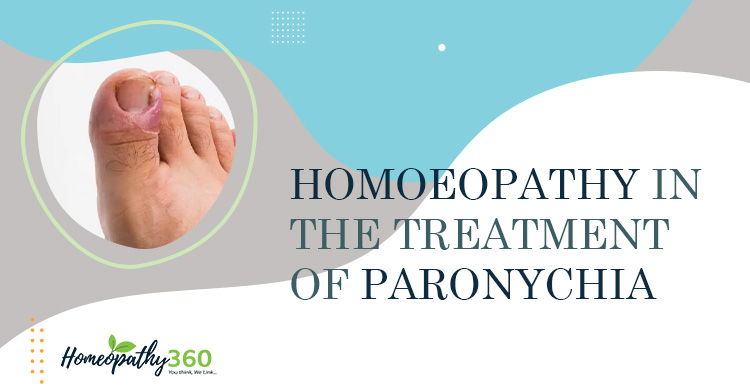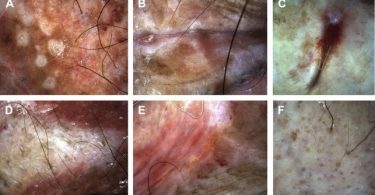
ABSTRACT
Paronychia is defined as the inflammation of the folds of tissue around the nails of a finger or a toe. Women are more prone than men as they are more exposed to water and irritants. Paronychia can be classified as acute paronychia or chronic paronychia. The main reason for development of Acute Paronychia is trauma to the cuticle or nail folds whereas frequent exposure to water, chemical and irritants are responsible for Chronic Paronychia. Homeopathy plays a major role in the control and cure of Paronychia. The need for surgery can be prevented if the history is recorded and physical examination are done properly.
KEYWORDS- Paronychia, Acute and Chronic Paronychia, Operative Treatment, Homoeopathic Therapeutics.
INTRODUCTION
Paronychia is among the commonest infection of the hand and foot. The term para means “around” and onyx means “nail”. Thus it involves the lateral and proximal part of the nails of the finger and toe folds, which includes the skin and tissue that borders the side and root of the nail. This may occur due to trauma, manipulation and sometimes spontaneously. When the protective barrier between the nail and nail fold is disrupted, it results in Paronychia. Mostly the Paronychia involves in single nail but can occur in many nails at a time due to drug induced conditions.1, 2
ANATOMY OF NAIL
The nail is longitudinal flanked by 2 lateral fold, or perionychium. Proximally, it is covered by the eponychium. Distal to the perionychium, the region immediately beneath the free edge of the nail is the hyponychium. The hyponychium serve as a tough physical barrier that resists bacterial infection.3
NAIL PLATE AND BED
The nail or nail bed lies immediately on top of the nail bed, which consist of the following 2 portions, which are involved in the production, migration and maintenance of nail.3
Proximal portion: called the germinal matrix contains active cells that are responsible for generating new nails damage to the germinal matrix result in malformed nails
Distal portion: called the sterile matrix adds thickness, bulk and strength to the nail.
NAIL FOLD
The nail arises from a mild proximal depression called nail fold. The nail divides the nail folds into 2 components: dorsal roof and the ventral floor both contain germinal matrices. Skin overlying the nail fold called nail wall.3
VASCULAR SYSTEM
Nail bed receives blood supply from 2 terminal branches of the volar digital artery. A fine network in the proximal nail bed and nail fold skin provide venous drainage and lymphatic drainage. Innervations are derived from the trifurcation of the dorsal branch of the volar digital nerve.4
PARONYCHIA
Paronychia is the most common hand infection in India, representing 35% of all infection of the hand. Susceptible people include those whose occupations require them to have their hand in prolong contact with water: such persons include Bartenders, florists, bakers and home makers.
Paronychia is more common in women than in men, with a female to male ratio of 3:1.5
Nail bed infection (paronychia) is a localized, superficial infection or abscess of the paronychial tissues (epidermis bordering the nail) of the hand. Any disruption of the seal between the proximal nail fold and the nail plate can cause acute infection of the eponychial space by providing a portal of entry for bacteria. In most of the cases (more then 80%) the infection caused by infective organism is the staph. aureus followed by strep. pyogens and gram negative bacilli.6
Clinically Paronychia presented as
1) Acute Paronychia
2) Chronic Paronychia
Acute Paronychia is an often tender infection of paronychium, which starts suddenly. The inflammation commence beneath the eponychium. Suppuration usually follows which may burrow beneath the base of the nail. So Paronychia means infection of the nail fold with or without extension deep to the nail. The infection is subcuticular since it is situated entirely within the dermis in which the nail is developed. The infection arises from careless paring or from manicurists unsterile instruments.
Chronic Paronychia resembles acute clinically, but the cause is multi factorial. It is usually non-suppurative and is more difficult to treat.4 The onset is insidious (the conditions has already existed for months) it follows acute Paronychia.
ETIOLOGY
ACUTE PARONYCHIA
1. Staphylococcus aureus is the most common infecting organism. Others are streptococci, pseudomonas, gram negative bacteria and anaerobic bacterias”.7
2. It may result from hang nails, penetrating trauma with or without retained foreign body or from activities such as nail biting, finger sucking, manicuring or artificial nail placement”.7
CHRONIC PARONYCHIA
1. Chronic Paronychia is primarily caused by yeast fungal Candida albicans.
2. It is common in those who repeatedly expose to water containing irritants and moist environments.7
3. Persons at high risk including, bartenders, housekeepers, dish washers and swimmers as well as diabetic and immune suppressed persons.5
4. Other rare causes of chronic Paronychia include bacterial, mycobacterial or viral infections, metastatic cancer, subungual melanoma and squamous cell carcinoma.
PATHOPHYSIOLOGY
A paronychial infection may develop, suddenly due to bacterial infection (acute) or may persist for month due to a fungal infection (chronic). Paronychia, whether it’s acute or chronic, results from a breakdown of the protective barrier between the nail crevice results in the bacterial or fungal colonization of the area’.
Inflammation commences beneath the eponychium usually suppuration follows confined by the coherence of eponychium to the base of the nail the inflammation advances around the nail fold, even to the contralateral side. In 60% of 25 the case pus burrows beneath the base of the nail to cause subungal abscess8
CLINICAL FEATURES
1) ACUTE PARONYCHIA
Patient with Acute Paronychia often present with a history of minor trauma to the fingertip or nail manipulation intentional or not.
The presenting are follows:
1. Pain
2. Tenderness
3. Swelling in one of the lateral folds of the nails.
4. Fever may be present because of inflammation.
2) CHRONIC PARONYCHIA:
Patients with Chronic Paronychia complain of symptoms lasting 6 weeks or longer. Inflammation, pain and swelling may occur episodically with boggy nail folds often after exposure to water or moist environment.9
DIAGNOSIS
The diagnosis of Paronychia is based primarily on patient history and physical examination. Some laboratory studies however can be useful. These includes following:
1. Gram staining and culture: to help identify a bacterial cause of fluctuant Paronychia.
2. Potassium hydroxide (KOH) 5% smears: to help diagnosis fluctuant Paronychia caused by a Candida infection.
3. Tack smear: if herpetic whitlow is suspected10
COMPLICATIONS
Paronychia can result in more serious infections such as,
1. Felon
2. Subungal abscess
3. Septic tenosynovitis
4. Osteomyelities
Such infections occur more readily in patients who are immune suppressed or whose condition is mistreated or neglected.11
DIFFERENTIAL DIAGNOSIS
Psoriasis and Reiter syndrome may also involve the proximal nail fold and can mimic Acute Paronychia. Recurrent acute Paronychia should raise suspicion for herpetic whitlow, which typically occurs in health care professionals as a result of topical inoculation. This condition may also affect apparently healthy children after a primary oral herpes infection. Herpetic whitlow appears as single or grouped blisters with a honeycomb appearance close to the nail. Diagnosis can be confirmed by Tack testing or viral culture. Incision and drainage is contraindicated in patients with herpetic whitlow. Suppressive therapy with a seven- to 10-day course of acyclovir 5% ointment or cream (Zovirax) or an oral antiviral agent such as acyclovir, famciclovir (Famvir), or valacyclovir (Valtrex) has been proposed, but evidence from clinical trials is lacking.10
TREATMENT
When the condition is in the infective stage, it may be cured by chemotherapy and by increase vasculature of the part by alternating tying and releasing a thread starting from the base of the finger up to the distal interphalangeal joint. As in majority of cases the causative organism is staph aureus, flucloxacillin is used.4
GENERAL MANAGEMENT11
| Type | Recommendation |
| All: | Avoid trimming cuticles or using cuticle removers. Improve glycemic control in patients with diabetes. Provide adequate patient education. |
| Acute Paronychia | Avoid nail trauma, biting, picking, and manipulation, and finger sucking. Keep affected areas clean and dry. |
| Chronic Paronychia: | Avoid finger sucking. Keep nails short. Use rubber gloves, preferably with inner cotton glove. |
PROGNOSIS
Chronic Paronychia responds slowly to treatment. Resolution usually takes several weeks or months, but the slow improvement rate should not discourage physicians and patients. In mild to moderate cases, nine weeks of drug treatment usually is effective. In recalcitrant cases, en bloc excision of the proximal nail fold with nail avulsion may result in significant cure rates. Successful treatment outcomes also depend on preventive measures taken by the patient (e.g., having a water barrier in the nail fold). If the patient is not treated, sporadic, self-limiting, painful episodes of acute inflammation should be expected as the result of continuous penetration of various pathogens.12
OPERATIVE TREATMENT
Operative treatment is advised when an abscess has developed. The pus should be let out by lifting the nail fold from the nail till the proximal end of the nail is reached when a small amount of pus will come out. This simple operation is quite painful should be done digital block. If pus has spread beneath the nail the proximal part of the nail ha separated from its bed and should be cut across with fine pointed but strong scissors. This will inevitably drain the whole of the abscess cavity.4
HOMOEOPATHIC CONCEPT
Aphorism (§)186 of Organon of Medicine, “The book of doctrines of homeopathy, written by Dr Hahnemann, describes the homeopathic approach on surgical conditions: “Those so-called local maladies which have been produced a short time previously, solely by an external lesion, still appear at first sight to deserve the name of local diseases. …The treatment of such diseases is relegated to surgery; but this is right only in so far as the affected parts require mechanical aid, whereby the external obstacles to the cure, which can only be expected to take place by the agency of the vital force, may be removed by mechanical means, e.g., by the reduction of dislocations, by needles and bandages to bring together the lips of wounds, by mechanical pressure to still the flow of blood from open arteries, by the extraction of foreign bodies that have penetrated into the living parts, by making an opening into a cavity of the body in order to remove an irritating substance or to procure the evacuation of effusions or collections of fluids, by bringing into apposition the broken extremities of a fractured bone and retaining them in exact contact by an appropriate bandage, etc.”13
Dr. Hahnemann goes on further by explaining that in surgical-aided cases, active dynamic aid is required to accomplish the work of healing.
HOMEOPATHIC THERAPEUTICS FOR PARONYCHIA
- Belladonna: Belladonna is recommended in the initial stage of the inflammation before the pus settles. The affected finger nail folds are red, tender and swollen. There is alternate redness and paleness of the skin.
- Graphites: Graphites is given when patient has paronychia with nails crack. Toe nails are crippled. The nails are brittle and break easily. It also treats when patient has deformity in the nails which are painful, sore, thick and crippled.
- Fluoric Acid: Fluoric acid is a remedy for Paronychia especially for old agers. There is inflammation of the finger joints. Sensation of a sphincter under the nail. Nails crumble. The nails grows too rapidly and crumbles with fungal infection.
- Hepar Sulph: Toe nails are painful on slight pressure. Abscess with suppurative prickling pain. Unhealthy skin: every little injury suppurates. The condition is chronic and recurring in nature.
- Tarentula Cubensis: Tarentula Cubensis is a toxaemic medicine and for septic conditions. It is adapted to the most severe type of inflammation and pain. Especially suited for senile ulcers.
- Silicea: Silicea is helpful for paronychia with pus, infection and sharp pains in nails. It is given especially if white spots are visible on the nails. It is also very good remedy for ingrowing toe nails. Patient has icy cold and sweaty feet.
- Myristica Sebifera: A remedy with great antiseptic powers. Traumatic infections, pain in the fingernails with swelling of the phalanges. Often prevents the use of surgeon’s knife. 14, 15, 16
BIBLIOGRAPHY:
- Rerucha CM, Ewing JT, Oppenlander KE, Cowan WC. Acute Hand Infections. Am Fam Physician. 2019 Feb.
- Sampson B, Lewis BKH. Paronychia Associated with Ledipasvir/Sofosbuvir for Hepatitis C Treatment. J Clin Aesthet Dermatol. 2019 Jan.
- Das S. A concise textbook of surgery. Dr. S. Das.; 2006.
- Williams NS, O’Connell PR, McCaskie A, editors. Bailey & Love’s short practice of surgery. CRC press; 2018 Apr 27.
- Rubin AI, Jellinek NJ, Daniel III CR, Scher RK, editors. Scher and Daniel’s nails: diagnosis, surgery, therapy. Springer; 2018 Jul 31.
- Rigopoulos D, Larios G, Gregoriou S, Alevizos A. Acute and chronic paronychia. American family physician. 2008 Feb 1.
- Vandervall K, Yehl MA, Tjiattas-Saleski L. Paronychia. Osteopathic Family Physician. 2018.
- Hay RJ, Baran R, Moore MK, Wilkinson JD. Candida onychomycosis—an evaluation of the role of Candida species in nail disease. British Journal of Dermatology. 1988 Jan.
- Paronychia (nail fold infection): Causes, Images, treatment, and more — DermNet [Internet]. Dermnetnz.org. 2022 [cited 16 September 2022]. Available from: https://dermnetnz.org/topics/paronychia
- Burns T, Breathnach SM, Cox N, Griffiths C, editors. Rook’s textbook of dermatology. John Wiley & Sons;
- Relhan V, Goel K, Bansal S, Garg VK. Management of chronic paronychia. Indian journal of Dermatology. 2014 Jan 1.
- Paronychia (nail fold infection): Causes, Images, treatment, and more — DermNet [Internet]. Dermnetnz.org. 2022 [cited 16 September 2022]. Available from: https://dermnetnz.org/topics/paronychia
- Hahnemann S. Organon of medicine. B. Jain publishers; 2002.
- Boericke W. Pocket Manual of Homoeopathic Materia Medica and Repertory. 9th Edition. New Delhi: B. Jain Publishers (P) Ltd. 2009.
- Nash EB. Leaders in Homoeopathic Therapeutics with Grouping and Classification. Low price edition. New Delhi: B. Jain Publishers. 2014.
- Clarke JH. A Dictionary of Practical Materia Medica. New Delhi: B. Jain Publishers. 1999.
About Author:
DR. MEBANPYNTNGEN RANI
MD-PART I, DEPT OF HOMOEOPATHIC PHARMACY
FATHER MULLER HOMOEOPATHIC MEDICAL COLLEGE DERLAKATTE, MANAGALURU




